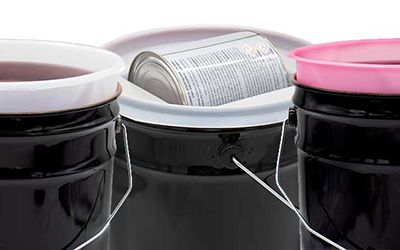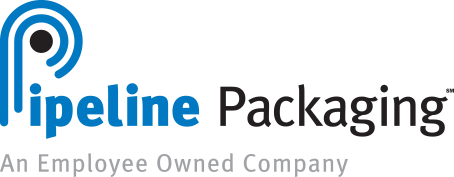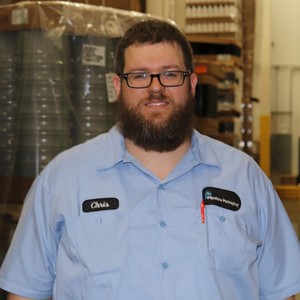When it comes to the packaging conversation, we tend to focus on the advantages and disadvantages of our primary components. While deciding between five-gallon HDPE pails and 10-lb. steel drums is important, smaller details like packaging coatings and liners can be another vital way to heighten the efficiency and cost-effectiveness of your packaging strategy.
Pipeline Packaging offers customers the ability to strengthen various packaging components through added features. Companies in many industries, including construction, automotive, and pharmaceuticals, deal with highly sensitive and potent chemicals that rely on additions like a coating or liner to heighten the strength of their packaging.
We explored every detail of two-part components — from Pipeline’s available lineup to an industry case study — to help reimagine your packaging system.

The Basics of Packaging Coatings and Liners
Coatings and liners are the most common form of two-part components. Not only do these additions prevent damage from chemical reactions to the body of the packaging, but they also serve as a mechanism for extending its life.
Though game-changing for many customers, it can be challenging to find a liner or coating that is compatible with your primary packaging and aligns with your specific project goals.
Coatings are a preferred choice for those using metal pails and drums. Many operations choose tin, aluminum, and steel containers for their durability, low reactivity, and temperature resistance. Despite its advantages, metal packaging also has the tendency to corrode over time.
By adding a rust inhibitor, you can slow the oxidation process, giving your packaging a longer working life. Other packaging coatings protect against other chemicals and environmental conditions. An epoxy phenolic lining, for example, bonds to the container so it can withstand acids, solvents, oils, and alkaline solutions.
Other popular packaging coatings include red, green, and gold phenolic linings.
Similar to chemical coatings, liners extend the life of your packaging by creating a protective barrier. Unlike coatings, though, liners can be removed and discarded as needed. This feature gives customers more opportunities for in-between uses. Their disposable nature also reduces the presence of residue, keeping packaging cleaner and free of contamination.
Like coatings, removable liners are available in various forms. Typically used in the adhesives and coatings industry, rigid inserts are popular for their ability to create a secure fit to pail walls. These inserts are also easy to remove and reuse.
Film liners stand on the other side of the packaging coatings and liners spectrum. A cost-effective alternative, these barriers utilize versatile materials, like LDPE and HDPE, for more industrial applications as well as ingredients and liquids.
Some liners have unique capabilities. For instance, an HDPE plastic paint can cradle allows operations to integrate multiple goods into one vessel. This liner offers a durable divide between a complete half-gallon paint can from other contents stored below the cradle.
Packaging coatings and liners can overcome short- and long-term challenges. Despite their benefits, finding compatible and practical liners can be a difficult task. As your packaging partner, the team at Pipeline can assist you in customizing your system, from finding chemically suitable coatings to sizing physical liners to your primary vessels.
Case Study: The Construction and Roofing Industries
In the construction and roofing industries, adhesives are integral in sealing the structural integrity of infrastructure projects. Through molecular bonding, these substances connect vital joints and protect surfaces from moisture damage. As strong chemical compounds, adhesives are often stored in two-part components with packaging coatings to guarantee the solution operates at peak performance without the risk of premature curing.
Account manager Carl Macris has been one of Pipeline’s Good People at the Core for 22 years. In that time, he’s worked closely with numerous customers in the industrial space, many of whom use packaging coatings. He shared his experience working with a chemical weatherproofing system manufacturer that has partnered exclusively with Pipeline Packaging for more than a decade.
“This customer manufactures a liquid weatherproofing system based on polyurethane resins,” said Macris. “Due to their chemical properties, the system is stored in a two-part component system comprised of a 3.5-gallon plastic pail topped with a tray liner that separates product stored at the bottom of the pail from a half-gallon F-Style HDPE bottle used to store the catalyst.”
When it’s time to use the product, the catalyst is poured directly into the base product at the bottom of the pail. Then, the product is ready for application, and the tray liner is recycled. Despite the steps, the complex two-part component system can store all the necessary ingredients in a manner that makes them secure and ready at a moment’s notice.
“That’s when the product works its magic,” noted Macris. “We handled some engineering for the packaging and helped purchase different elements from different manufacturers.”
When it comes to building systems that incorporate details like packaging coatings, Pipeline Packaging eases the pressures facing customers by providing access to more than 400 global suppliers through a single source. Through a comprehensive partnership, we can also offer customers other benefits like savings on freight and warehousing, consolidated POs, and engineering expertise.
Pipeline’s multitude of products and services allows us to guide customers toward the perfect comprehensive packaging solution.
Regarding the adhesive manufacturer, Macris noted that Pipeline provided several improvements to its packaging coatings system.
“First, we modified the plastic pail cover by taking out the gasket,” he said. “Instead, the tray liner operates as the gasket. This improvement eliminated some redundancy from the packaging.”
The primary containers were also adjusted.
“Originally, the company was purchasing steel pails,” added Macris. “But to save costs and build sustainability, Pipeline helped the customer switch to plastic pails.”
One Packaging Partner for Every Need
Two-part components are not as common as other types of packaging systems. While packaging coatings and liners are their most popular form, these complex units are specially crafted to handle specific products like epoxy coatings and heavy industrial applications.
“We do what we can to partner with our customers to ensure they’re getting exactly what they need,” said Macris.
By nurturing relationships with customers, Macris and his team ensure Pipeline is a trusted resource in meeting their packaging coatings and liner specifications while uncovering other opportunities to optimize their operations.
From the most complex packaging to the simple choice between plastic and metal pails, Pipeline Packaging is equipped to fulfill every packaging need. Contact us today to develop your packaging system with maximum precision.


